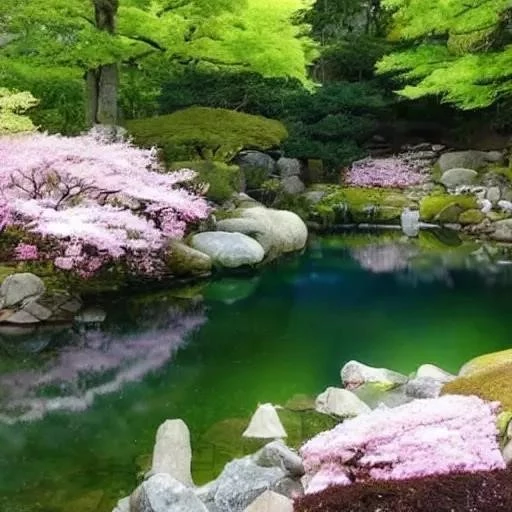
Discover the profound serenity and enduring beauty encapsulated within Japan’s iconic horticultural masterpieces.
In our increasingly frenetic modern existence, finding pockets of tranquility and natural beauty becomes not merely a luxury but a profound necessity. Many seek solace in meticulously curated spaces, yet few can rival the unparalleled depth and spiritual resonance offered by a traditional Japanese flower garden. Far transcending the Western concept of a vibrant floral display, these revered landscapes are living artworks, carefully sculpted narratives of nature, philosophy, and human contemplation. They are, quite remarkably, designed not just to be seen, but to be felt, to be experienced, inviting a deep engagement that rejuvenates the spirit.
Imagine stepping into a realm where every stone, every stream, and every delicate bloom plays a vital role in a grand, harmonious symphony. This is the essence of a Japanese garden, an intricate tapestry woven from centuries of aesthetic principles, Buddhist philosophy, and Shinto reverence for nature. By integrating insights from ancient traditions with a keen eye for subtle seasonal changes, these gardens masterfully create miniature natural worlds. They are incredibly effective at transporting visitors from the mundane to the magnificent, offering a timeless sanctuary where the soul can truly breathe. It’s a journey into an art form that prioritizes balance, symbolism, and an understated elegance.
Key Elements & Philosophical Foundations of Japanese Gardens
| Aspect | Description | Philosophical Significance |
|---|---|---|
| Water (Mizu) | Ponds, streams, waterfalls, or even raked gravel (representing water). | Purity, renewal, life force, continuity; often symbolizes the ocean or a river journey. |
| Rocks (Ishi) | Carefully selected and placed stones, representing mountains, islands, or deities. | Permanence, strength, stability, creation; often arranged in symbolic groupings (e.g., a trinity). |
| Plants (Shokubutsu) | Evergreen trees (pine, bamboo), moss, azaleas, cherry blossoms, maples, irises. | Seasonal beauty, endurance, life cycles; each plant carries specific cultural symbolism. |
| Lanterns (Tōrō) | Stone lanterns originally for illumination, now primarily decorative. | Enlightenment, guidance, spiritual light; often placed at key viewing points. |
| Bridges (Hashi) | Wood, stone, or earthen bridges, crossing water or dry streams. | Transition, connection, crossing from one world to another (e.g., mundane to sacred). |
| Borrowed Scenery (Shakkei) | Incorporating distant landscapes (mountains, trees) into the garden’s design. | Expands the perceived space, harmonizes the garden with its surroundings, connects to the larger natural world. |
| Wabi-Sabi | An aesthetic embracing imperfection, transience, and natural simplicity; | Finds beauty in the aged, the humble, and the subtle, promoting appreciation for the ephemeral nature of life; |
| Asymmetry | Deliberate avoidance of perfect symmetry in design. | Reflects the natural world’s inherent irregularity, creating a more dynamic and engaging composition. |
The Artful Integration of Flora: Beyond Mere Blooms
While the term “flower garden” might evoke images of sprawling beds bursting with color, the Japanese interpretation is far more nuanced and profound. Here, flowers are not the singular stars of the show but rather carefully chosen accents, providing seasonal highlights and symbolic meaning. Consider the ephemeral beauty of the sakura (cherry blossom), signifying the transient nature of life, or the vibrant azaleas, meticulously pruned into rolling hills that mimic natural landscapes. Irises often grace water features, adding splashes of purple and white, while the delicate camellia offers winter interest. Each bloom is selected for its specific contribution to the overall aesthetic and its ability to evoke a particular feeling or moment in time, contributing to a truly immersive experience.
Moss, often overlooked in Western horticulture, is revered in Japanese gardens, forming lush, emerald carpets that symbolize age, tranquility, and the enduring power of nature; Pine trees, sculpted over decades, represent longevity and steadfastness, their gnarled branches reaching skyward. The emphasis is always on creating a harmonious balance between evergreen and deciduous elements, ensuring visual interest throughout the year, truly embodying a holistic approach to landscape design. This careful curation, involving painstaking effort and deep reverence for natural forms, transforms these spaces into living poems.
A Sanctuary for the Soul: The Enduring Appeal
The optimistic vision embodied by a Japanese garden extends beyond its physical boundaries, permeating the very spirit of those who encounter it. These aren’t merely decorative spaces; they are philosophical treatises rendered in stone, water, and foliage, inviting introspection and fostering a deep connection with the natural world. From the contemplative dry landscapes (karesansui) of Zen temples, designed for meditation and abstract thought, to the expansive stroll gardens (chisen-kaiyu-shiki) offering a changing vista with every turn, each style serves a distinct purpose, enriching the human experience. Visiting these gardens, one can’t help but feel a sense of calm washing over them, a gentle reminder of life’s inherent beauty.
In a world constantly accelerating, the principles guiding the creation of a Japanese garden offer invaluable lessons in mindfulness, patience, and the appreciation of subtle beauty. They remind us that true grandeur often lies not in ostentatious display, but in meticulous detail and thoughtful arrangement; The future of landscape design, increasingly recognizing the importance of well-being and environmental harmony, stands to gain immensely from these ancient practices. Embracing the profound artistry of a Japanese flower garden can, undoubtedly, transform our perspectives, offering not just an escape, but a pathway to a more balanced and enlightened existence. It’s an investment in serenity, a testament to enduring beauty, and an invitation to discover peace within ourselves.
